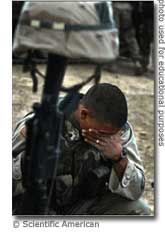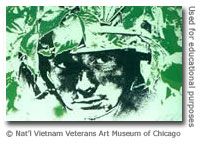 With the military stretched thinner than it's perhaps ever been, service members from all branches are increasingly faced with taking on new roles these days. Combat duty is no longer the sole job of the soldier or the Marine; and so, traditional battlefield fighters may no longer be the only ones asked to bear war's psychological burdens. Let's take a look at how the Air Force and Navy are affected by this broadening of combat roles and responsibilities in their ranks.
With the military stretched thinner than it's perhaps ever been, service members from all branches are increasingly faced with taking on new roles these days. Combat duty is no longer the sole job of the soldier or the Marine; and so, traditional battlefield fighters may no longer be the only ones asked to bear war's psychological burdens. Let's take a look at how the Air Force and Navy are affected by this broadening of combat roles and responsibilities in their ranks.
Click on 'Article Link' below tags for more...
First, let's take a look at the changes taking place in the Air Force via this article in today's Houston Chronicle:
When a group of U.S. Air Force commanders visited Iraq two years ago, they made some disturbing observations as they watched enlisted airmen working in the war zone. Many lacked basic combat skills and instincts. Some didn't know how to handle and load their weapons. A few even had their guns taken away as a safety precaution.
Within months, the high command mandated an overhaul of Air Force basic military training, which has been conducted here since 1942. Officials now say they've imposed the most dramatic changes in 60 years in the training's tone and curriculum.
Chief among them is a new, time-consuming emphasis on "warrior ethos," making every airmen capable of self defense in a service with a reputation for being removed from the front lines. The 38,000 trainees per year now spend less time learning to fold T-shirts so they can spend more time learning to wage war.
With 46 deaths recorded among airmen in Iraq — many of them in ground combat roles — trainees are embracing the new approach as a way of improving their survival chances in their almost-certain deployments to the war zone.
We're introduced to a couple of the newest trainees (classes began in November); after three weeks, one 19-year old airwoman is now confident in firing her M-16A2 training rifle. The only other weapon she'd ever fired up to that point was a BB gun.
That's more exposure to weapons than trainee Amanda Reed of Burlington Township, N.J., had before arriving for basic training, which now features rifle-handling from the outset. "I'm getting used to it. We still haven't fired them — we do that next week," she said. Her family wasn't aware of the new push for combat training, but "when I told them I was learning to use an M-16, my younger brother was very enthusiastic about that."
Like many recruits, Reed joined the Air Force with the notion that it wouldn't be as perilous as other service branches. "I still think that the Air Force isn't as dangerous as the Army or Marines," Reed said.
On his last day in basic, Alex Gaines, 20, of Portage, Ind., said he's ready to move on to training in electronics, but he's prepared to use combat skills if required. The former fast-food worker said he benefited greatly from the grueling training. "I have a lot more confidence, a lot more discipline. We learned how to work as a team," although it was tough initially, he said. "The first couple of weeks, we were like, 'What have we gotten ourselves into?' After that, it didn't get easier, but you adjusted to it," Gaines said. "They (instructors) pretty much want to see if they can break you down."
Trainee Jose Castro, 19, of Little Rock, Ark., agreed. "You try your hardest to do everything right and they just never gave you enough time to actually do it right or finish it. I guess that was the whole point, to stress you out. That's what was hardest for me," he reflected, on the eve of graduation.
As the first in his family to join the military, Castro said his decision wasn't embraced. He portrayed the Air Force as a relatively safe experience to win his family's support. "That's what I actually explained to my mother to make her at least accept it, because she wasn't too happy with it," Castro said.
Trainee Amber Huber, 21, a former waitress and bartender from Alma, Wis., said combat scenarios were among the toughest ordeals. "Once you get used to that, it's not bad," Huber said.
It's a bit of a bait and switch; but, our armed forces being what and who they are rise to the occasion time and again. Some Air Force stats are given:
- Women make up 1/4 of the Air Force
- Minorities make up 1/3
- Average age of new enlistees, 20.2 years
- 1/4 have some college or a degree
- Shortest basic training of all branches (will be increased by 2 weeks next year)
- 800 new trainees arrive weekly
- 93% will make it through basic training
- 84% complete that training in the standard 6 1/2 weeks
Go ahead and read the rest of the article to get a feel for what an average day of this branch's basic training is like; I'll close out our look at the Air Force with this quote:
"Now we're doing war skills training up front. We're prepping to deploy. What we did was shave off as much time as we could from the airmanship skills, and we put that into war skills training," the commander said.
A tad unnerving of a consideration.
Of course, if Air Force service members must be placed into combat roles, they need to get the proper war skills training. But stating it in terms of reducing the airmanship skills of an airman and replacing them with combat skills sounds to be a great loss in many ways.
The blending of the roles of our military branches seems to be a significant marker, a significant change in our modern military. As with traditional Guard and Reserve roles, the Air Force is quickly learning there are no longer clear lines of separation from one branch of service to the next: they're all in the Army now.
But the Air Force isn't the only branch of the military remolding itself -- the Navy is, too. Let's take a glimpse at some of the changes happening in that branch via this weekend's Norfolk Virginian-Pilot:
At 9 a.m. on a normal weekday, Lt. Jon French would be checking his e-mail, refilling his coffee cup and probably offering legal advice to a Norfolk sailor. Instead, the Navy lawyer, 28, spent Thursday morning crowded into the back of a truck with a dozen other Kevlar-clad troops, cradling an M-16, his eyes scanning the woods of this Army training base for "insurgents."
French, who works at Norfolk Naval Station's trial services office, left normal behind in December, when he agreed to go to Iraq so his married colleagues didn't have to leave their families . For the next year, French will work with Task Force 134, helping Iraqi lawyers and judges prosecute insurgents rounded up by U.S. forces. "It never occurred to me that I would ever be in combat boots with a rifle," said French, who joined the Navy while he was at Gonzaga University School of Law. "Anybody who's in uniform has to be ready to answer the call when it comes, and it did this time."
That call is coming for more and more sailors. Adm. Mike Mullen , the chief of naval operations, has told his ranks that the Navy will step up its contribution to the war on terror by increasing the number of "individual augmentees" filling support roles in Iraq and Afghanistan.
Unfortunately, the downside here is that by tapping people not originally intended for these types of deployments creates a problem or two. The work and position they've left behind remains unfilled. More importantly, however, family members of these "individual augmentees" (or IAs) are left to deal with the stress of deployment on their own.
Unlike what's been built up over decades in the Army and the Marines, what's lacking in the other branches is a support structure to help these families navigate smoothly through this unusual -- and generally unplanned for -- event. Air Force, Reserves, Guard, Navy...they're all going to have to find a way to deal with this new reality because it's here, and it doesn't look to be going anywhere anytime soon.
In March, the Navy cut orders for more than 900 sailors to leave their posts for Middle Eastern combat zones. An additional 400 were tapped in April, said Rear Adm. Daniel Holloway , one of the Navy's top personnel officers. Overall, about 11,000 sailors are on the ground in the Middle East, said Navy spokesman Lt. Trey Brown . That includes mobilized reservists, augmentees and Navy units. That number has steadily increased since the United States invaded Afghanistan and Iraq, he said.
The increased commitment to sending individual augmentees into harm's way led the Navy to develop a two-week training program at Fort Jackson. The base in South Carolina's capital also puts Army recruits through basic training and gives refresher training to retired soldiers called back to active duty.
Before the classes began in January, Navy augmentees trained at Fort Bliss, Texas, or Fort Benning, Ga., where some deploying Navy units go to brush up on combat skills. It's like fast-track basic training, without the marching and in-your-face discipline. The sailors here learn to shoot machine guns, clear a building, frisk enemy prisoners of war and toss grenades.
Fast-track training? Although this isn't something I've looked into yet (but, certainly have plans to), I hope our Naval (and Air Force) troops aren't being short-changed along with fast-tracked.
After 25 years on ship and shore duty, Chief Warrant Officer Mark Rees is headed to Afghanistan, where he'll work with an Army unit training Afghan police. It's a big change for someone who specializes in the Aegis weapons system and had been serving aboard the destroyer James E. Williams .
Rees, who lives in Suffolk, said the physical adjustment of operating with a helmet, body armor and rifle has been his biggest challenge. "I don't normally carry an M-16. On a ship, I carry a pen and a notebook, and I write things down," Rees, 42 , said during a break from drills. "Every kid, I think, plays Army," he said. "Doing it this late in life, with real people shooting at you, may not be the smartest thing."
His wife is not enthused about his next tour, but Rees is being a good sport. "In my opinion, if we can help the Afghans, it's a good thing," he said, "if they want the help."
Rees and Chief Warrant Officer Chris Logan of Virginia Beach have had about a month to prepare for their new task.
Logan, a father of three, had been working at the Navy-Marine Corps Warfighting Intelligence Center at the Fleet Combat Training Center at Dam Neck when he got a phone call five weeks ago telling him he was on a short list to go to Afghanistan.
It wasn't a surprise. With his experience in intelligence, Logan figured he'd get tapped. He's happy he'll be working alongside Army personnel and that it's a six-month tour instead of a year. "I'd rather take directions from an Army guy on the ground than a Navy guy," Logan said. "Not that a Navy guy isn't competent, but they're more experienced," he said, referring to the soldiers.
That last quote goes back to the concern I raised earlier -- a solid point that needs to be considered as we continue down this road of expecting all branches to be ground war capable.
Brig. General James H. Schwitters , the commanding general of Fort Jackson, said the most important thing for sailors to learn is "operational awareness" -- knowing what to look for and what not to do if a fight breaks out around them. Schwitters, who last year finished a tour in Iraq helping to set up that country's army, said he worked with individual augmentees from other U.S. military branches and saw for himself they needed more training for emergencies.
He isn't worried about soldiers mistrusting the sailors who serve alongside them. "I'm not naive enough to think there aren't individuals who would feel that way," Schwitters said while at the training site, "but that almost never becomes a problem."
The drill sergeants took a few good-natured jabs at their Navy charges but said they're impressed by the attitude of the sailors, who are about evenly split between active and reserves.
Though the sailors are good-natured and interested in succeeding in their changing roles (they're in the 'Narmy' now, they say), their new responsibilities demand an increased awareness and ability to quickly react to situations they have until recently not been physically and mentally trained for.
For Cmdr. Bill Kern, the training and his upcoming tour in Iraq are a chance to combine academics and life experience. Kern teaches military strategic studies at the Air Force Academy in Colorado.
Thursday, Kern learned the hard way that teaching tactics and carrying them out are two different things. Acting as leader of a group of 15 sailors on a convoy exercise, Kern ran into all sorts of trouble when the "fog of war" descended in the form of a simulated attack.
His sailors were supposed to dismount and take cover in the woods, but instead of fanning out as they'd practiced, they clumped too close together. Half the group abandoned the right side of the truck and traipsed to the left, leaving the vehicle open to attack. Kern lost track of the radio operator who was supposed to stay by his side.
Through it all, the drill instructors quietly prodded Kern and his team: "Where's your radio?" "Leapfrog back and maintain security." "Get behind a tree. Not a skinny tree. Something that's going to stop a bullet."
When the exercise ended, Kern and at least seven of his team members had their helmets off -- a signal that the insurgents had "killed" them. Kern was brutally honest when the drill instructors asked him during a debriefing what his team did well. "It's a short list," he said, blaming himself for many of the lapses. "All the things we were taught, we weren't employing," he said. "We just kind of ran around willy-nilly."
French, the lawyer, was one of the bareheaded sailors. He and four teammates were ambushed as they rushed around a building. It was just a drill, and he hopes he won't see anything close to combat when he's in Iraq. Still, the experience left him with a sinking feeling. "When you come around the corner and see a guy standing there and you try to raise your weapon and you don't and your whole team dies, ..." French said, his voice drifting off. "There's so much to pay attention to."
My hopes are that both the Navy and the Air Force -- if they absolutely must place their service members into on-the-ground combat roles -- will continue to test and strengthen their training for these service members. It will ensure their own safety, as well as the safety of those they serve with.
Please consider thanking the Houston Chronicle and Norfolk's Virginian-Pilot for their coverage of this important development in the way our modern military is undergoing such a breathtaking metamorphosis.

Related
PTSD Statistics, WWII to Iraq
 I'll be away from my computer until Monday, soaking up a family event. Back to posting PTSD news early next week.
I'll be away from my computer until Monday, soaking up a family event. Back to posting PTSD news early next week. One Senator is reporting some good news re: veteran's health, if it holds. Senator Schumer says the Senate is not likely to back at least one provision of President Bush's 2007 proposed
One Senator is reporting some good news re: veteran's health, if it holds. Senator Schumer says the Senate is not likely to back at least one provision of President Bush's 2007 proposed 
 Wow, the editorial board at the Seattle PI comes out swinging for our troops and the families that have to help them heal as they return home in Thursday's (now online) Opinion: "The slogan adorns bumper stickers and those yellow-ribbon trunk magnets: 'Support Our Troops.' Great slogan. But is it anything more?" Find out what's got them so tweaked, and be sure to
Wow, the editorial board at the Seattle PI comes out swinging for our troops and the families that have to help them heal as they return home in Thursday's (now online) Opinion: "The slogan adorns bumper stickers and those yellow-ribbon trunk magnets: 'Support Our Troops.' Great slogan. But is it anything more?" Find out what's got them so tweaked, and be sure to 
 The people in Ohio are doing an outstanding job of standing up in support of our troops in tangible and important ways. This weekend I wrote of a new support program, the
The people in Ohio are doing an outstanding job of standing up in support of our troops in tangible and important ways. This weekend I wrote of a new support program, the  With the military stretched thinner than it's perhaps ever been, service members from all branches are increasingly faced with taking on new roles these days. Combat duty is no longer the sole job of the soldier or the Marine; and so, traditional battlefield fighters may no longer be the only ones asked to bear war's psychological burdens. Let's take a look at how the Air Force and Navy are affected by this broadening of combat roles and responsibilities in their ranks.
With the military stretched thinner than it's perhaps ever been, service members from all branches are increasingly faced with taking on new roles these days. Combat duty is no longer the sole job of the soldier or the Marine; and so, traditional battlefield fighters may no longer be the only ones asked to bear war's psychological burdens. Let's take a look at how the Air Force and Navy are affected by this broadening of combat roles and responsibilities in their ranks. What are some of the differences between this war and others that have been fought in the past, and how do those differences add to or subtract from the possible after effect known as posttraumatic stress disorder? One military chaplain
What are some of the differences between this war and others that have been fought in the past, and how do those differences add to or subtract from the possible after effect known as posttraumatic stress disorder? One military chaplain 
 The news splashed across our television screens and our newspapers today: the Army reported its suicide rate figures yesterday. Although our armed forces have been increasingly working to ensure their troops receive mental health/stress support, the rate has still inched upwards to levels not seen since 1993. The data is heartrending.
The news splashed across our television screens and our newspapers today: the Army reported its suicide rate figures yesterday. Although our armed forces have been increasingly working to ensure their troops receive mental health/stress support, the rate has still inched upwards to levels not seen since 1993. The data is heartrending. If you're in the Madison, WI area, you're invited to a limited engagement exhibit,
If you're in the Madison, WI area, you're invited to a limited engagement exhibit,  Yesterday, I received this email:
Yesterday, I received this email: The DOD has once more
The DOD has once more 

